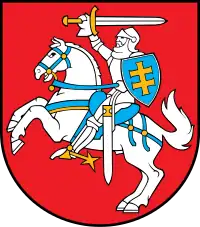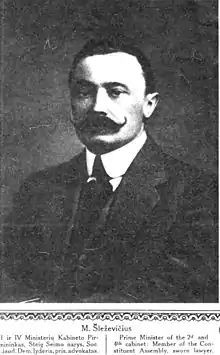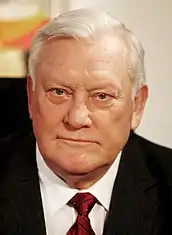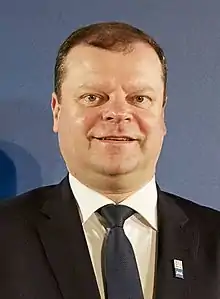Prime Minister of Lithuania
The prime minister of Lithuania (Lithuanian: Ministras Pirmininkas, literally translated as Minister-Chairman) is the head of the government of Lithuania. The prime minister is Lithuania's head of government and is appointed by the president with the assent of the Lithuanian parliament, the Seimas. The modern office of prime minister was established in 1990, when Lithuania declared its independence, although the official title was "Chairperson of the Council of Ministers" until 25 November 1992.
| Prime Minister of the Republic of Lithuania | |
|---|---|
 | |
| Style | Mr./Madam Prime Minister |
| Appointer | President of Lithuania |
| Term length | Legislative elections to the Seimas are held every four years at most and newly elected Seimas approves the Prime Minister. No term limits are imposed on the office. |
| Inaugural holder | Augustinas Voldemaras |
| Formation | 11 November 1918 |
| Salary | €40,000[1](annual,after tax) |
| Website | https://ministraspirmininkas.lrv.lt/en/ |
Historically, the title of Prime Minister was also used between 1918 and 1940. This was during the original Republic of Lithuania, which lasted from the collapse of the Russian Empire until the country's annexation by the Soviet Union.
Republic of Lithuania (1918–1940)
| Nº | Name (Born–Died) |
Portrait | Term of office[2] | Political party | |
|---|---|---|---|---|---|
| 1 | Augustinas Voldemaras (1883–1942) 1st time |
 |
11 November 1918 | 26 December 1918 | Party of National Progress |
| 2 | Mykolas Sleževičius (1882–1939) 1st time |
 |
26 December 1918 | 5 March 1919 | Peasant Union |
| 3 | Pranas Dovydaitis (1886–1942) |
 |
13 March 1919 | 12 April 1919 | Lithuanian Christian Democratic Party |
| (2) | Mykolas Sleževičius (1882–1939) 2nd time |
 |
12 April 1919 | 2 October 1919 | Peasant Union |
| 4 | Ernestas Galvanauskas (1882–1967) 1st time |
 |
7 October 1919 | 15 June 1920 | Independent |
| 5 | Kazys Grinius (1866–1950) |
 |
19 June 1920 | 18 January 1922 | Lithuanian Popular Peasants' Union |
| (4) | Ernestas Galvanauskas (1882–1967) 2nd time |
 |
2 February 1922 | 17 June 1924 | Independent |
| 6 | Antanas Tumėnas (1880–1946) |
 |
18 June 1924 | 27 January 1925 | Lithuanian Christian Democratic Party |
| 7 | Vytautas Petrulis (1890–1942) |
 |
4 February 1925 | 19 September 1925 | Farmers' Association |
| 8 | Leonas Bistras (1890–1971) |
 |
25 September 1925 | 31 May 1926 | Lithuanian Christian Democratic Party |
| (2) | Mykolas Sleževičius (1882–1939) 3rd time |
 |
15 June 1926 | 17 December 1926 | Lithuanian Popular Peasants' Union |
| (1) | Augustinas Voldemaras (1883–1942) 2nd time |
 |
17 December 1926 | 19 September 1929 | Lithuanian Nationalist Union |
| 9 | Juozas Tūbelis (1882–1939) |
 |
23 September 1929 | 8 June 1934 | Lithuanian Nationalist Union |
| 12 June 1934 | 6 September 1935 | ||||
| 6 September 1935 | 24 March 1938 | ||||
| 10 | Vladas Mironas (1880–1953) |
 |
24 March 1938 | 5 December 1938 | Lithuanian Nationalist Union |
| 5 December 1938 | 28 March 1939 | ||||
| 11 | Jonas Černius (1898–1977) |
 |
28 March 1939 | 21 November 1939 | Lithuanian Nationalist Union |
| 12 | Antanas Merkys (1887–1955) |
 |
21 November 1939 | 15 June 1940 | Lithuanian Nationalist Union |
Following the ultimatum in June 1940, the forces of Soviet Union entered Lithuania, prompting President Antanas Smetona to flee the country. Antanas Merkys, who assumed the position of acting president in accordance with the constitution, soon announced he had taken over the Presidency on a permanent basis and appointed Justas Paleckis, favored by the Soviet authorities, as the Prime Minister ahead of the "people's government". Merkys soon resigned, allowing Paleckis to assume the post of acting president as well.[3] The presidency of Merkys is not recognized as legitimate in modern Lithuania[4] and Paleckis is not listed as an interwar Prime Minister in government sources.[2]
| Nº | Name (Born–Died) |
Portrait | Term of office | Political party | |
|---|---|---|---|---|---|
| Justas Paleckis (1899–1980) |
 |
17 June 1940 | 24 June 1940 | ||
Lithuanian Soviet Socialist Republic (1940–1990)
- Chairman of the Council of People's Commissars of the Lithuanian SSR
- Mečislovas Gedvilas (25 August 1940 – 2 April 1946) (in exile in the Russian SFSR 1941–1944)
- Chairmen of the Council of Ministers of the Lithuanian SSR
- Mečislovas Gedvilas (2 April 1946 – 16 January 1956)
- Motiejus Šumauskas (16 January 1956 – 14 April 1967)
- Juozas Maniušis (14 April 1967 – 16 January 1981)
- Ringaudas Songaila (16 January 1981 – 18 November 1985)
- Vytautas Sakalauskas (18 November 1985 – 17 March 1990)
Provisional Government of Lithuania (1941)
- Acting Prime Minister of the Provisional Government
- Juozas Ambrazevičius (June 23, 1941 – August 5, 1941)
 |
|---|
| This article is part of a series on the politics and government of Lithuania |
Republic of Lithuania (1990–present)
From 11 March 1990 after adopting the Act of the Re-Establishment of the State of Lithuania.
- Parties and affiliations
Sąjūdis LDDP TS / TS-LKD LLS LSDP LVŽS
| Nº | Name (Born–Died) |
Portrait | Legislature (Election) |
Term of office[5][Note 1] | Political party | |
|---|---|---|---|---|---|---|
| 1 | Kazimira Prunskienė (1943–) |
Supreme Council (1990) |
17 March 1990 | 10 January 1991 | Independent (endorsed by Sąjūdis) | |
| 2 | Albertas Šimėnas (1950–) |
 |
10 January 1991 | 13 January 1991 | Independent (endorsed by Sąjūdis) | |
| 3 | Gediminas Vagnorius (1957–) 1st time |
.png.webp) |
13 January 1991 | 21 January 1992 | Independent (endorsed by Sąjūdis) | |
| 4 | Aleksandras Abišala (1955–) |
 |
21 January 1992 | 26 January 1992 | Independent (endorsed by Sąjūdis) | |
| 5 | Bronislovas Lubys (1938–2011) |
.jpg.webp) |
Sixth Seimas (1992) |
27 January 1992 | 10 March 1993 | Independent (endorsed by Democratic Labour Party) |
| 6 | Adolfas Šleževičius (1948–) |
 |
10 March 1993 | 8 February 1996 | Democratic Labour Party | |
| 7 | Laurynas Stankevičius (1935–2017) |
 |
23 February 1996 | 19 November 1996 | Democratic Labour Party | |
| (3) | Gediminas Vagnorius (1957–) 2nd time |
.png.webp) |
Seventh Seimas (1996) |
4 December 1996 | 3 May 1999 | Homeland Union (Conservatives) |
| 8 | Rolandas Paksas (1956–) 1st time |
 |
1 June 1999 | 27 October 1999 | Homeland Union (Conservatives) | |
| 9 | Andrius Kubilius (1956–) 1st time |
 |
3 November 1999 | 19 October 2000[6] | Homeland Union (Conservatives) | |
| (8) | Rolandas Paksas (1956–) 2nd time |
 |
Eighth Seimas (2000) |
27 October 2000 | 20 June 2001 | Liberal Union |
| 10 | Algirdas Brazauskas (1932–2010) |
 |
4 July 2001 | 15 November 2004[7] | Social Democratic Party | |
| Ninth Seimas (2004) |
29 November 2004 | 1 June 2006 | ||||
| 11 | Gediminas Kirkilas (1951–) |
 |
6 July 2006 | 17 November 2008 | Social Democratic Party | |
| (9) | Andrius Kubilius (1956–) 2nd time |
 |
Tenth Seimas (2008) |
28 November 2008 | 16 November 2012[8] | Homeland Union – Lithuanian Christian Democrats |
| 12 | Algirdas Butkevičius (1958–) |
 |
Eleventh Seimas (2012) |
26 November 2012 | 14 November 2016 | Social Democratic Party |
| 13 | Saulius Skvernelis (1970–) |
 |
Twelfth Seimas (2016) |
22 November 2016[9] | 13 November 2020 | Independent (endorsed by Farmers and Greens Union) |
| 14 | Ingrida Šimonytė (1974–) |
 |
Thirteenth Seimas (2020) |
25 November 2020[10] | Incumbent | Independent (endorsed by Homeland Union) |
See also
Notes
- Term of office starts when the Prime Minister is appointed by presidential decree and starts forming the government. Term of office ends when the Prime Minister or the government is dismissed or their resignation is accepted by presidential decree. Term of office does not include the time served in an acting capacity, typically until the next Prime Minister forms a new government.
References
- https://m.delfi.lt/verslas/verslas/article.php?id=79837533
- "Ankstesnės Vyriausybės. Laikotarpiu 1918-1940". Government of the Republic of Lithuania. Retrieved 9 May 2016.
- Senn, Alfred Erich (2007). Lithuania 1940: Revolution from Above. Rodopi. pp. 147–148. ISBN 9789042022256. Retrieved 9 May 2016.
- "History". President of the Republic of Lithuania. Retrieved 9 May 2016.
- "Ankstesnės Vyriausybės. Po 1990 metų". Government of the Republic of Lithuania. Retrieved 29 April 2016.
- "DĖL LIETUVOS RESPUBLIKOS VYRIAUSYBĖS GRĄŽINAMŲ ĮGALIOJIMŲ PRIĖMIMO IR PAVEDIMO JAI EITI PAREIGAS". Seimas of the Republic of Lithuania. Retrieved 29 April 2016.
- "DĖL LIETUVOS RESPUBLIKOS VYRIAUSYBĖS GRĄŽINAMŲ ĮGALIOJIMŲ PRIĖMIMO IR PAVEDIMO LAIKINAI EITI PAREIGAS". Seimas of the Republic of Lithuania. Retrieved 29 April 2016.
- "DĖL LIETUVOS RESPUBLIKOS VYRIAUSYBĖS GRĄŽINAMŲ ĮGALIOJIMŲ PRIĖMIMO IR PAVEDIMO JAI LAIKINAI EITI PAREIGAS". Seimas of the Republic of Lithuania. Retrieved 13 May 2016.
- "DELFI ŽINIOSDIENOS NAUJIENOSLIETUVOJE D. Grybauskaitė premjeru paskyrė S. Skvernelį". Delfi.lt. BNS. Retrieved 22 November 2016.
- https://www.lrp.lt/data/public/uploads/2020/11/2020-11-25-nr.1k-443.pdf
External links
- (in Lithuanian) Official site